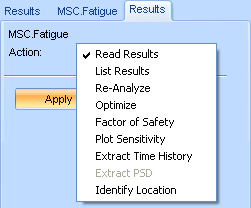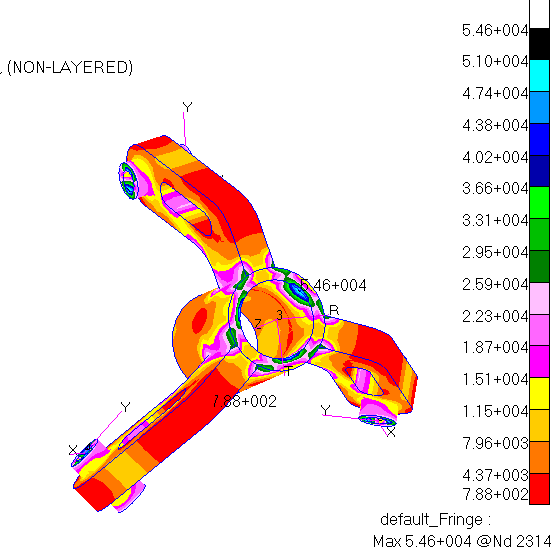XXXXXXXXXXXXXXXXXXXXXXXXXXXXXXXXXXXXXXXXXXXXXXXXXXXXXXXXXXXXXXXXXXXXXXXXXXXXXXXXXXXXXXXXXXXXXXXXXXXXXXXXXXXXXXXXXXXXXXXXXXXXXXXXXXXXXXXXXXXXXXXXXXXXXXXX''"> Review the Results
Before we actually look at the results of this analysis, let us try and predict approximately what the life prediction will be. This will help solidify some of the concepts introduced in this chapter. We can do this because the loading is simple, constant amplitude, and has zero mean. We need the following information first:
1. Node with highest stress: Node 2314
2. Maximum Principal Stress: 58,732 PSI
3. Young’s Modulus: 2.776e7 PSI
4. Strain = Stress/E: 2.12e-3
Hint: | An easy way to recover the Maximum Principal Stress is to use the Report function in the Results application. Press Results application switch on main Pre & Post or MSC Patran form. Set the Action/Object to Create/Report. Select Stress Tensor | Max Principal. Change the mode of the form to Target Entities (the second button icon) and change the Target Entity to Nodes and type in Node 2314. Click Apply. The report is sent to the invoking UNIX or DOS window. |
Now before doing anything else, look this strain level up on the strain-life curve: 55,900 reversals = 29,110 cycles. To do this yourself, go to the Material Info... form and invoke the database manager and graphically plot the strain-life plot for BS4360-50D. Using the left mouse button, click on the curve to have the coordinate locations reported to you in the lower left corner of the graphics screen. (On UNIX the coordinates are reported above the graphics on the plot command line.) This will of course be an approximation.
Now correct for plasticity. The value we just read off the curve was using the elastic strain only. To find out what the elastic-plastic strain is we need to use the cyclic stress-strain curve for BS4360-50D. We need to solve this equation for σ and ε, knowing σe and εe: σeεe = σε = 124.5. This has to be done using trial and error. Graphically display the cyclic stress-strain curve. Then use the mouse as you did on the strain-life curve to find a stress and a strain that lies on the stress-strain curve that has the product of approximately 124.5. This again will be an approximation. You may end up with slightly different answers than reported here if you perform this exercise yourself: ε = 2.835e-3, σ = 45,290. Quit from PFMAT when you are done if you followed this exercise.
Hint: | It might help to zoom in on the area of interest of the curve for a more accurate coordinate reading. Either press the right mouse button in the bottom left zoom corner and again in the top right zoom corner or use the View | Window X and Window Y options and type coordinate values in. |
Now look this new value of strain up on the strain-life as you did before. So our guess is that the life prediction will be around 22,2880 reversal = 11,440 cycles.
Note: | The S-N curve usually is reported as stress range (ΔS) versus cycles to failure (N). The ε-N curve is usually reported as strain amplitude (εa) versus reversals to failure (2N). Be aware of these facts since they could throw your calculations off by a factor of two or more if you think you are using range instead of amplitude or reversals instead of cycles. |
View the Life Contour Plot
Open the Results... form on the main MSC Fatigue setup form (not to be confused with the Results application switch on the main Pre & Post or MSC Patran form). With the Action set to Read Results, click Apply. The fatigue analysis results have been read into the database.
Now go to the Results application in Pre & Post or MSC Patran and plot the Log of Life (Cycles). Set the Action/Object to
Create/Quick Plot. Select the
Crack Initiation result case and
Log of Life (Cycles). Click the Apply button. Note that the smallest life reported is at
Node 2314 of approximately

= 13,346 Cycles, very close to our hand calculation of 11,440 cycles.


